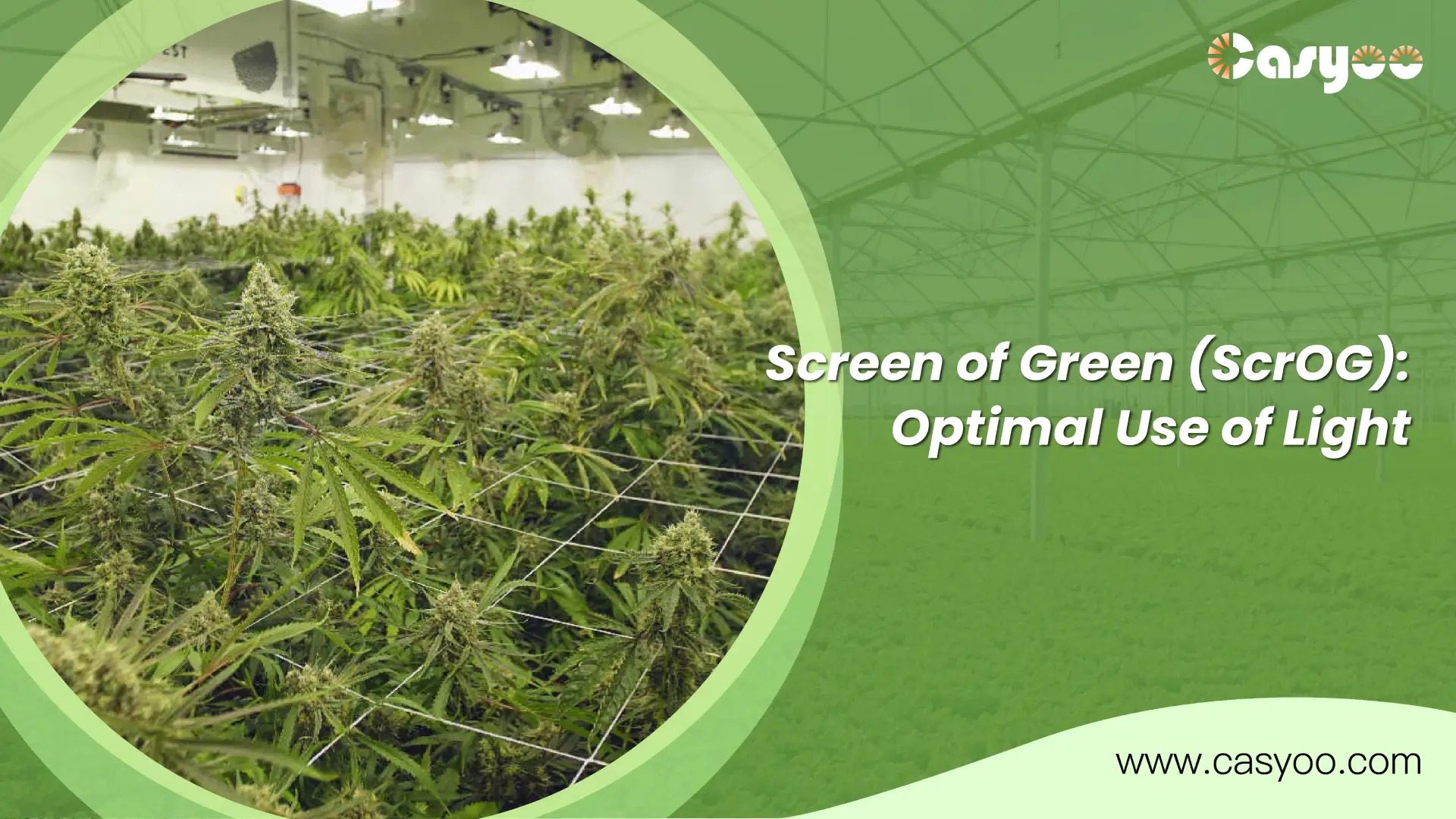Everybody wants to maximize their growing space. But you might only be able to grow one or two plants for a variety of reasons. But don’t worry, you can still get a good harvest with just one plant. With the help of screen of green (ScrOG), you can maximize your yield without increasing the space or plants required. This post will cover the fundamentals of ScrOG, show you how to get started with a setup of your own, and guide you through advancing the method by integrating it with LST, Mainlining, Superclipping, and other techniques.
What is Screen Of Green (ScrOG)?
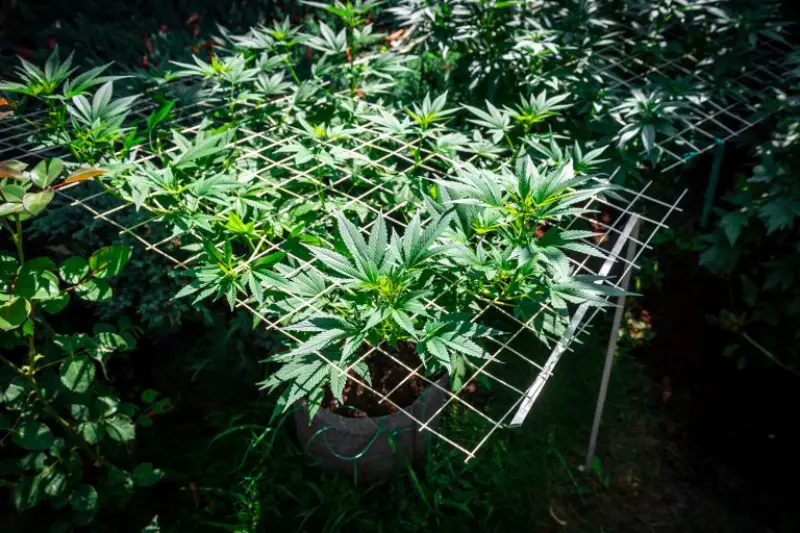
The screen of green, or ScrOG for short, is one of the training techniques designed to address the natural apical dominance of cannabis. It directs and controls the growth of many cannabis plants by using a screen as a trellis.
ScrOG is designed to elevate lower branches and lower top branches to create an even canopy that allows for better distribution of light to all bud sites. During the vegetative stage, ScrOG helps control the growth of leaves to make the most of limited space in a grow room or grow tent. ScrOG encourages uniform light delivery at all bud sites during the flowering phase, which results in larger buds and increased yields.
What are the Benefits of ScrOG?
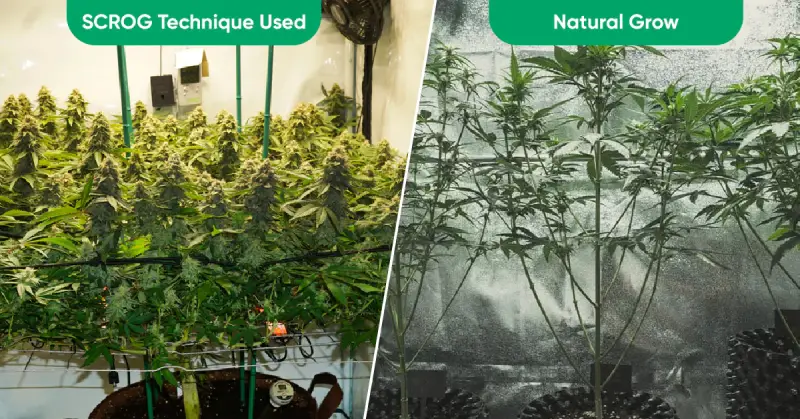
ScrOG has some very distinct advantages over other growing techniques.
Suitable for a small space
Towering plants are the last thing you want in a small grow area because only the buds closest to the lights will fully open. If your growing area is small, using ScrOG can greatly aid with canopy balancing, which will guarantee that all bud sites receive an equal amount of light from the grow lights.
Strong Light Penetration
One of the common problems growers face is poor light penetration in the canopy. This often occurs in smaller grow rooms or tents where plants overlap each other resulting in poor light penetration. ScrOG can help you solve this problem.
Higher Yields
If the cannabis plants are growing well on their own, using ScrOG can greatly increase your yield and quality.
What are the disadvantages of ScrOG?
Time
Training a plant takes time, at least 2-3 weeks. This can be twice as long if you use the mainline training technique (we’ll get to that technique later). In contrast, many SOG growers skip the vegetative stage entirely and go straight to the flowering stage.
Risks
Don’t put all your eggs in one basket. If something happens, your entire harvest and months of work can quickly go up in smoke.
What are the differences between Sea of Green (SOG) and Screen of Green (ScrOG)?
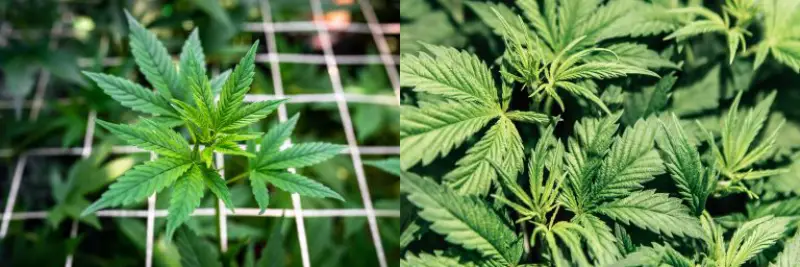
Since the concepts of ScrOG and SOG are similar, people frequently mix up the two approaches. However, there are some distinctions between them.
The SOG approach is to grow several plants with little side branches. When attempting to develop as many plants as possible in a tiny grow room, minimal branching guarantees a good central cola.
In contrast, ScrOG encourages side branches to optimize bud positioning. You can use netting or horizontal wire trellises to train the branches so that the blooms receive the necessary amount of light. All new growth can be kept uniformly tucked under the screen to produce a crown of buds.
SOG is the more beginner-friendly solution because the plants require less training. Of course, there’s no reason you can’t introduce ScrOG later if you notice your plants are getting out of control. ScrOG is also a fantastic strategy to maintain consistent yields if you can keep up with the training, particularly if your cannabis plants grow at various speeds.
Regardless of the growth technique you choose, you’ll maximize the growing space you have available and make sure your business runs as smoothly as possible. Essentially, an SOG canopy consists of a single large cola from each plant, while a ScrOG canopy consists of numerous branches from one or more larger plants.
What are the Best Strains for ScrOG?
White Berry
White Berry is a 75% Indica-dominant strain that packs a strong punch. It is capable of producing large, frosty, and heavy buds while growing to a very manageable height. If you like strains with strong sedative effects and need to maximize space with a ScrOG setup, this strain may be a good choice. White Berry flowers can be harvested in just 7 weeks and can provide a very respectable indoor harvest.
Green Ice Cream
It is a balanced hybrid that grows to a medium height of around 120cm and responds very well to ScrOG with some regular topping and pruning. You can cultivate many Green Ice Cream plants in 12–15 liter pots in your room to truly maximize your yield and make the most of the restricted area because of its short, stocky shape.
Bruce Banner
It is a hybrid that grows quickly and leans slightly toward Sativa. It can be trained to take up an entire screen in a small indoor tent or room because it grows up to 150 cm indoors and can yield THC levels of up to 27%. Keep in mind that this strain will also stretch out quite long before flowering, so be sure to get used to its long, lanky branches.
When to do a ScrOG setup?
Once the plants begin to make contact with the screen, you can begin to guide them through the screen. We recommend placing the screen about 20 cm above the plants.
Start “folding” each plant when its tip starts to protrude through the screen. Hold off until every tip is 5 cm above the screen. Proceed to tuck every single shoot beneath the screen and direct them through the subsequent square. Maintain this procedure throughout the duration of the vegetative phase.
To encourage flowering, switch to a 12/12 light cycle after the screen is nearly full.
Over the next 2-3 weeks, as your plants begin to stretch, continue to tuck and braid each branch.
How to Grow Cannabis with the Screen of Green (ScrOG) method?
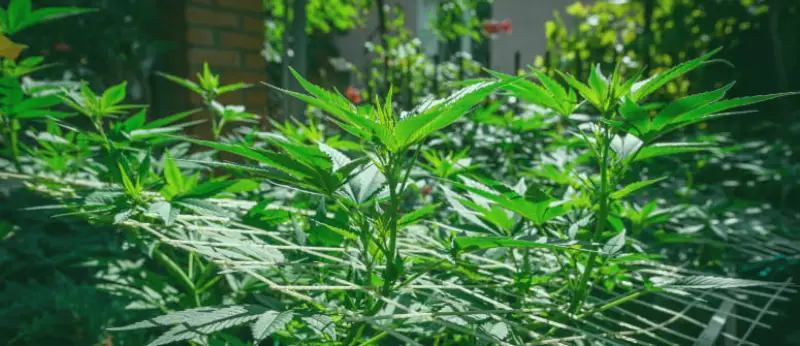
Your plants will transition from the seedling stage to the vegetative phase after a few weeks.
Here’s what you’ll do:
Topping
After each plant has grown 5 nodes, you’ll need to top the plant at the highest node. Just above the intersection, trim the main stem with a clean, sharp pair of scissors. Topping forces the plant to shift its growth into several main stems instead of just one. This promotes lateral growth that is more suitable for the ScrOG method.
Setup
Position the screen about 20-40 cm above the growing medium (depending on the type of plants you are growing). Position the lights in a way that provides an even light exposure across the screen.
Weaving
Cannabis branches are not like vines. You need to manually weave them into the screen. The objective is to place a single branch in each square to prevent crowding. Don’t take the chance of breaking off a branch if you don’t want it to grow in a certain direction. Fill the screen with branches going in different directions to prevent shadows and crowding. Continue weaving throughout the early flowering period until the screen is filled.
Pruning
Prune branches from just below the top of the plant. Your plant will be forced to focus all of its energy on the crown as a result of this.
Maintenance
Make sure to water them immediately after each weaving. Next, water the soil only when the top 3-4 cm have dried completely. Give your plant optimal nutrition to avoid nutrient deficiencies.
Enhance Screen of Green (ScrOG) with other cannabis training techniques
ScrOG produces excellent results when used alone, but combining it with other techniques can help take the results to an even higher level.
Lollipopping
The lollipopping method, as the name implies, is that your plant should end up like a lollipop – with no leaves on the stem and a large, juicy head or bud on top.
Lollipops are similar to pruning in many ways, but they are a bit more aggressive and involve removing all foliage from the base of the plant (including leaves, branches, and even buds) This increases aeration and diverts energy to larger, more efficient buds elsewhere in the canopy.
This technique is well suited to the ScrOG method because it encourages the growth of buds above the screen and inhibits the emergence of inferior “popcorn” buds on the lower portions of branches.
When doing lollipops, be sure to use sterile scissors or razor blades to cut away leaves, as tiny lesions made around the plant stem can allow bacteria, fungi, and other parasites to penetrate the plant. Also, be sure to give the plant plenty of time to recover, as this technique can be very stressful.
LST
In low-stress training, the cannabis plant is trained to grow around objects like screens or in specified directions by carefully bending and tying its branches. Since there is no significant stress, the plant takes almost no time to recover after this process.
LST can be applied in a variety of methods during ScrOG. Tying the plant’s tip and arranging the main stem parallel to the ground allows farmers to push side branches upward, resulting in a more productive canopy. As an alternative, tie four main branches in an “X” shape using LST after topping. This will force your plant to grow sideways and encourage it to fill up more space on the screen. This method works great when you want to grow a large plant, such as a resilient sativa, in ScrOG, for example.
Mainlining
Mainlining planting is an advanced growing technique that t make the most of its limited resources by distributing them uniformly to every bud site. It’s basically a combination of topping, lollipop topping, and LST, and it functions incredibly well in ScrOG when used correctly.
Mainlining planting basically entails topping a plant more than once at the same node. It will then start to form several branches that grow simultaneously. Certain ScrOG experts will grow a plant and top it five times on each side of the plant and then develop 32 primary branches that can be trained to form a perfectly symmetrical canopy that fills the screen.
In addition to giving you complete control over how your plant grows, mainlining helps the plant distribute nutrients and water from the soil to the bud points, putting an end to popcorn buds and giving you plenty of colas.
Superclipping
Use super clipping to increase the pliability and ease of braiding of your branches. Using this high-stress technique, branches are meticulously pinched and squeezed until they nearly shatter. This improves light penetration while also improving the plant’s suitability for ScrOG.
Final thoughts
ScrOG is a technique that can transform your cannabis harvest potential. If you can master the SCROG technique, and maximize your light levels, you will get amazing yields. You can grow them with our full spectrum LED lights.
